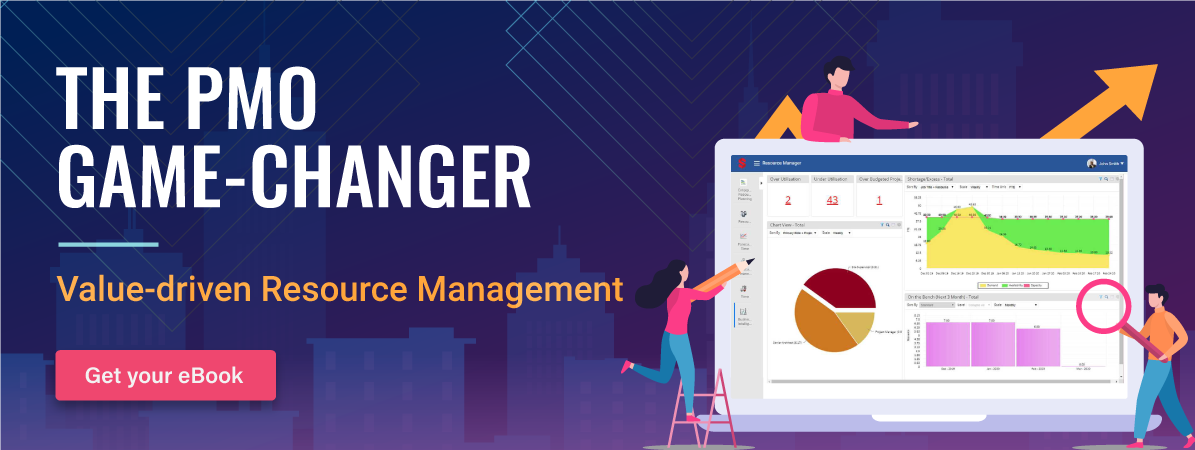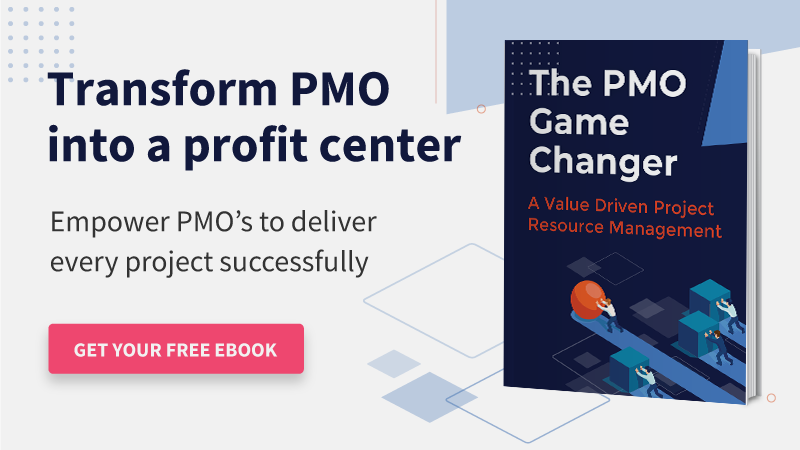“It is not the strongest of the species that survive, nor the most intelligent, but the ones that are most responsive to change.” – Charles Darwin
Indeed, all businesses can relate to this quote since they strive to walk along with the novel technology and trends and stay relevant in the long haul. The same goes for the PMOs
A PMI research states that-
More than 55 percent of PMO directors say the charter for their PMO has changed in the past five years.
Traditional PMOs have focused on overseeing the tactical activities of a program, project, or portfolio following the same old reporting standards and charts. As a result, organizations still relying on this conventional form have failed to adapt to change and have fallen short of their potential.
In today’s business landscape, PMOs need to be seen as transformational and leading edge rather than being a support system or an administrative body. Thus, they have to be more receptive to technological innovation and take on a more authoritative position to scale up business efficiency and profitability.
If there’s anything that is at the core of maintaining the resource health index and delivering projects successfully, it’s a value-driven PMO!
In this blog post, we’ve compiled some strategies to transform PMO rightfully as a value-producing entity.
How does a value-driven PMO differs from a cost-based PMO?
A PMO is the nerve center of a project-driven business. It takes on various functions such as supportive, controlling, and directive as per firm requirements.
As PMOs are changing and evolving their remit. So, what distinguishes the modern-day value-focused PMO from the traditional or a cost-based PMO?
Let’s see,
Traditional PMO
The conventional role of the PMO is to improve operational efficiency by performing activities such as creating business cases, maintaining reports, logbooks, etc. However, traditional PMOs focus only on annual planning and follow a ‘one size fits all’ approach instead of being agile. Thus, they are not well equipped to deal with the changing market demands and client requirements.
The major setback of the traditional PMOs is that they don’t continually evaluate the strategic competence of the projects. Instead, they focus on completing administrative or operational activities to reduce the workload of project managers.
Modern PMO
In today’s highly competitive business landscape, the role of a PMO is no longer limited to performing administrative functions. A modern-day PMO serves more than just ensuring timely project delivery or functioning as a cost center for the project-based business. Instead, it acts as a value-centric profit center by maintaining a degree of control or playing a directive role in project management.
It ultimately regulates the projects by being actively involved in project selection, assigning a project manager who reports back to the PMO, framing project and resource management strategies, maximizing productive utilization, and, most importantly, meeting the firm’s strategic objectives.
In a nutshell, a value-driven PMO with its high governance and control manages every aspect of the project from the start until completion. This is why forming a value-driven PMO is the need of the hour.
Read More: Top 10 Business Benefits of a Value Centric PMO
Now that the importance of having a value-centric PMO is established, let’s address another pressing question.
Who runs or governs the Program Management Office? – The Program Director
The concerned person is responsible for looking after all the activities within the PMO at a granular level. From selecting the right projects that drive profits to taking a holistic view of all projects and assisting project managers, they cater to all.
Let’s look at the roles and responsibilities of the program director in detail here.
What is the role of the program director in PMO?
The Program Management Office (PMO) ensures that business project operations are executed effectively and efficiently. The program director is in charge of developing and maintaining project management methodologies, putting in place the appropriate tools and technology. They are certified professionals with more than ten years of experience as a Senior Program Manager, Project Manager, or PMO Officer.
The program director’s key role dimensions include:
- Creating and managing a project/program management office (PMO).
- Developing ways to monitor and control the multiple project delivery cycle.
- Supervising and ensuring that hiring and staffing needs are met in accordance with program goals and project demands.
- Ensuring that the PMO fulfills performance goals and other KPIs.
- Work as a strategic adviser for project prioritization with corporate leaders.
- Manage the risk, and change resolution processes, and work with the appropriate authorities to take corrective action as necessary.
- Extend necessary support to Project Managers to deliver projects/programs on time, within the scope, and on budget.
Before understanding how to build a value-centric PMO, let’s first look at its primary functions and how they help deal with the pressing challenges.
How will a value-driven PMO solve project and resource-centric challenges?
A PMO can don multiple hats, and its benefits typically differ from business to business, depending upon its nature, size, and goals. However, on common ground, a PMO is focused on delivering value, and it also provides managers necessary support to combat the specific challenges.
Here is an overview of how a value-centric PMO can help managers mitigate several projects and resource-related challenges.
Facilitate project selection and prioritization
The projects that a company undertakes decide the firm’s profitability and help to achieve long-term business objectives. The PMO is crucial in developing standard project selection criteria to evaluate and analyze each project. It allows you to take up profitable and strategically aligned projects and ensure that your company’s resources are utilized at the right place.
If any initiatives fail to satisfy the organization’s objectives, resources will be wasted, negatively impacting the bottom line. As a result, one of the most important roles of a value-driven PMO is to prioritize and choose projects.
Read More: 5 Project Selection Criteria to Structure the PMO
Define and formulate project management methodologies
PMOs define and implement project management methodologies based on the project’s nature and attributes. It allows them to standardize project-related activities and processes for the specific project teams. In simple terms, the project manager will have better clarity on how a project should be managed throughout its cycle, from creating initial business cases to delivery management.
For instance, a PMO may favor linear delivery methodologies such as the Waterfall approach or prefer a more Agile delivery framework. They may also select a hybrid process by choosing the best practices from both waterfall and agile. Thus, implementing these methodologies and standardizing the project metrics across all business units minimizes the chances of discrepancies and helps to improve overall project performance.
Streamline resource requisition workflow
After projects have been selected and prioritized, it is critical to find and assign competent resources to suitable opportunities. Thus, PMO serves as a central point of contact in resource requisition workflow and keep track of the audit trail for better transparency.
Depending on the project managers’ estimation, resource managers can fill the open positions based on project priority. Moreover, in case of any internal conflicts for critical resources, PMOs can intervene and help to find common ground with project managers, using the audit trail effectively. In addition, when an automated requisition workflow is followed, PMOs can leverage that to foster a shared service model.
Read More: 5 Easy Steps to Request Resources Efficiently
Optimize resource schedules for better utilization
As stated earlier, the Project Management Office acts as a vital link between project and resource managers and plays an integral role in maintaining the resource health index. Since under or overutilization of resources can lead to missed deadlines, lower productivity, employee burnouts, and even attritions, PMOs keep track of forecast vs. actual resource utilization levels.
If they spot any red flags, they direct the managers to take suitable resourcing measures to solve the issue. Additionally, resource managers can coordinate with the project managers and implement the right resource optimization technique to optimize the resources’ schedules while keeping the project constraints in mind.
Bridge the skill gap to futureproof the workforce
Since value-driven PMOs are directly involved in project-related activities, they proactively gauge the resource demand for the pipeline projects in the opportunity or approval stage and evaluate the skills gap. Then, in order to bridge this gap and diversify the workforce’s skill set, they implement necessary training, upskilling workshops, conferences, or provide other learning modules and support to the respective teams. This allows PMOs to futureproof the workforce and enables them to accomplish more diverse projects with fewer resources.
In addition, the project managers are also given formal leadership and other project-related training to ensure effective project management. All these initiatives benefit both the managers and teams by keeping them abreast of industry best practices, emerging methodologies, or management techniques. It also increases the sustainability of the firm and helps maintain a competitive edge.
Read More: Importance of skill development in making your workforce future-ready
Oversee project delivery cycle
Instead of directly managing projects, PMOs provide expert assistance and audits the project delivery mechanisms. They track the milestone completion and ensure that all bottlenecks are addressed in a controlled way. Moreover, they also ensure that any scope change is first communicated and seek approval from the change control board before implementing them.
Their main aim is to facilitate project success and ensure on-time project delivery within a specified budget. For instance, if the PMO observes any cost escalation or delay in achieving the milestones, they intervene and take necessary steps to bring the project back on track. Moreover, PMOs implement essential tools and technology to get these updates in real-time and with precision.
Develop an overall resource risk management plan
A Project Management Office plays a vital role in creating a resource risk management plan so that the project does not suffer. They stay abreast and coordinate with managers to mitigate issues such as loss of employee productivity, shortage of resources, skill gaps, unplanned absences, or retirement. PMOs also help managers conduct succession planning if they foresee any critical resource leaving the organization and keep their projects on track.
In addition, they capture and disseminate the lessons learned around completed projects into the repository for future reference. Finally, they make sure the firm doesn’t make the same recurring resourcing mistake over and over again.
Read More: What Is a Risk Matrix and Why It Is Important?
H. Build reusable assets and apply them to different projects
For strategic alignment and effective portfolio management, the organization must reuse the assets from the inventory meticulously. This approach reduces project management costs and acts as a time-saving strategy. For instance, if a particular project builds a specific tool, the PMO preserves the same in an inventory, thus creating an asset. Going forward, if another project needs the same tool, the PMOs can provide this as a reusable asset and assist project managers in adapting to it.
Moreover, PMOs consolidate all project-related data and documents it into a central database. They can deploy a cloud computing system to keep the back-ups and security in check and provide them to the managers when they undertake similar projects.
Procure the right tool inventory to speed up project activities
The Project Management Office is responsible for selecting and implementing the right tools and technology to speed up and streamline project management activities. These tools are purposely designed to break down projects into a series of phases, automate repeatable tasks, and foster seamless team collaboration.
For instance, using the resource management tool, PMOs and concerned managers can access the real-time reports on various resource metrics (utilization, availability, forecast vs. actual, etc.), consolidate the data, and make data-driven decisions. It also features simulation functionality (what-if analysis) and advanced analytics to improve resource planning. This also helps increase productivity, form the best-fit resource plan based on project constraints, and optimize resource utilization.
Read More: How to Select the Best Software Using Cost-Benefit Analysis?
The functions outlined above can be described as the core activities of a majority of PMOs. Now, let’s talk about how a resource management solution can become a significant game-changer for a value-driven PMO.
How does resource management help a value-driven PMO?
All the planning in the world won’t make a difference unless we schedule the right resources for the right project at the right time. As efficient and intelligent utilization of resources decides the bottom line of the firm. Companies and PMOs can effectively leverage project resource management software and ensure productivity and profitability.
Foresee pipeline project demand through capacity planning
The PMO’s primary responsibility is to ascertain that every project is executed with due diligence and without last-minute firefighting. Resource management tool with integrated capacity planning solutions provides foresight into the resource demand based on which managers can forward plan pipeline projects.
Moreover, they can also find the resource excesses and shortfalls using the capacity vs. demand report and take appropriate measures to bridge the gap.
Ensure timely project delivery with competent resource allocation
An effective resource management solution provides unmatched visibility into the resource attributes such as skills, location, experience, availability, utilization, etc. Thus, using an advanced filter, resource managers can ensure competent resource allocation.
At the same time, the real-time updates in the multidimensional schedules allow PMOs to oversee the workforce allocation on multiple projects. In case they notice any discrepancy in allocation or scheduling, they coordinate with the resource manager to course correct the situation. This enables PMOs and managers to ensure successful project delivery within time and budget.
Read More: What is Resource Allocation? A Comprehensive Guide for Project Success
Minimize the complexities of matrix boundaries
In matrix organizations, resources have multiple reporting lines, I.e., they have one or more managers. This can create many resourcing complexities, such as scheduling conflicts, as every project manager will deem their project critical. However, this situation can be tackled using a resource management tool. PMOs can ensure that cross-functional teams are formed seamlessly based on the project’s criticality.
In addition, the tool provides 360-degree visibility of every resource-related data. This helps managers evaluate resource availability, skill-matrix and allocate the best available resources to the right task at the right cost. It is particularly useful for critical resources that have to be shared across projects.
Get Real-time insight into useful resource metrics
A modern resource management solution gives you real-time insight into the various resource metric from availability, utilization to capacity vs. demand, etc. This is particularly helpful in a multi-project environment as the concerned authorities can view all the data-driven insights to take corrective actions ahead of time.
PMOs can assess the resource performance on a timely basis by following the real-time reports. This includes heat maps on resource utilization which gives accurate information about billable, non-billable, and strategic utilization, resource availability reports, planned vs. actual metrics, and so on. Then, leveraging the data, they can direct resource managers to form a course action plan ahead of time to secure the project’s fate and regulate the resources’ health index.
Read More: What Is Resource Lifecycle, and Why Is It Important?
Ascertain effective bench management
An ideal PMO aims to significantly reduce the idle time between projects and ensure their human capital generates enough revenue or adds value rather than being on the bench. For instance, when resources end up on the bench, their billable utilization gets affected. Therefore, one must stay ahead of schedule and know which resource will likely end up on the bench.
With advanced forecasting solutions in place, resource managers can actively propose resources to other projects before they hit the bench and manage ramp-down activities well. If the PMOs see an unusual increase in bench size or witness bench aging, they can intercept and adjust project timelines or escalate strategic work.
Minimize last-minute hiring/firing cycles
Last-minute firefighting for resources is harmful in 2 ways. For one, it escalates project resourcing costs, and for two, managers may have to settle with a less-qualified resource just to begin the project proceedings. The tool can minimize these cycles by forecasting project requirements ahead of the curve. It will help managers to find the skills gap in advance and ensure planned hiring. PMOs can predict this demand, evaluate the project resource plan, and signal the resource managers to initiate resource planning.
This way, resource managers get enough lead time to procure the best-fit talent for the project and the firm. It also eliminates wrongful hiring that affects the project’s quality and output. Thus, before the project initiation, PMOs can ensure that they have the right resource mix for the projects.
Read More: Project Resource Management: An Ultimate Guide on How to Master it
This way, resource management can be a great value addition to the PMOs in two crucial ways: by centralizing enterprise-wide resources and allowing PMOs to form a data-driven project resource management strategy.
Conclusion
Each organization has its own programs and initiatives with its unique strategic goals. Therefore, the importance of a PMO to upkeep organizational efficiency and excellence cannot be understated.
According to PMI, even during the covid times, PMO acted as the resilient bridge and helped project teams sail through these unprecedented times seamlessly.
If your business has always viewed your PMO as an expense instead of an asset, it is time to start examining how you can reframe your perspective, follow the aforementioned insights to build a value-driven PMO, and articulate your business to drive success.
The Glossary
Read More: Glossary of Resource Workforce Planning, Scheduling and Management
The SAVIOM Solution
SAVIOM is the market leader in offering the most powerful and configurable solutions for managing enterprise resources efficiently and effectively. Having more than 20 years of experience, this Australian-based MNC has a global presence in over 50 countries. It is also popular with more than 100 customers and helps them achieve their business goals. SAVIOM also has products for project portfolio management, professional service automation, and workforce planning software which can be easily customized as per business requirements.












